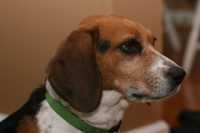
19 Jun Highly Trained Beagles Can Smell Lung Cancer in Serum
MedicalResearch.com Interview with:
Thomas A. Quinn, DO, FAOCOPM
Clinical Professor
Lake Erie College of Osteopathic Medicine
Bradenton
MedicalResearch.com: What is the background for this study? What are the main findings?
Response: Canine scent detection of lung cancer is showing evidence of being an effective, safe and cost effective method of early detection of lung as well as other types of cancer.
Lung cancer is the leading cause of cancer deaths and early detection has proven to be one of the most effective ways to reduce the mortality and morbidity of this deadly disease. In a collaborative study conducted by the Lake Erie College of Osteopathic Medicine (LECOM) and BioScentDX, a canine training and research facility, we were able to show that highly trained dogs can detect non-small cell cancer of the lung by scent alone. For this study we chose to use Beagles because of their superior scent capability as well as their temperament, sociability and easy trainability. The dogs proved to be able, in this double blind study, to detect lung cancer in blood serum with a 96.7% sensitivity and a 97.5% specificity. The dogs underwent an eight-week training program using the clicker/treat training method. We trained four Beagles for this study but one of the dogs did not respond well to the training methods and had to be removed from the program. That dog was retrained as a service dog for a handicapped child.
MedicalResearch.com: What should readers take away from your report?
Response: Certain dogs, from the scent hound group such as Beagles, can be trained to use their scent detection capability to detect lung cancer with a high degree of accuracy. In the Journal of the American Osteopathic Association article, the dogs detected lung cancer using blood serum. Our research continues and we have also trained dogs to detect cancers using saliva and exhaled breath samples with equal accuracy. We are also successfully training dogs to detect breast and colorectal cancers. The samples can be easily collected at the physician’s office or clinic and sent to the BioScent Laboratory for evaluation by the dogs. When evaluating an unknown sample, every sample is examined by four separate dogs to assure accuracy. Every dog is routinely retested every three months, using known positive and negative samples, to assure that the dogs maintain their level of accuracy. If the accuracy of any dog declines they are removed from the program to be retrained and then retested. They are returned to the program only after their accuracy returns to accepted levels.
MedicalResearch.com: What recommendations do you have for future research as a result of this work?
Response: We are barely scratching the surface in this new and exciting research. Just a few of the multiple areas that need to be investigated are: Can the dogs detect small cell lung cancer (SCLC) as well as non-small cell lung cancer (NSCLC)? Can the dogs, by scent alone, distinguish between SCLC and NSCLC? At what stage can the dogs detect recurrent lung cancer? Will chemotherapy medications effect the dogs ability to detect recurrence of cancer? Will certain medical conditions, such as diabetes, have an effect on the dogs ability to detect cancer? Right now we have more questions than answers.
Our researchers at LECOM are also attempting to fractionate and identify the biomarkers that the dogs are identifying in the lung cancer positive exhaled breath condensate samples. At each stage of the fractionation the samples are presented back to the dogs to determine which of the fractionations contain the cancer biomarkers. Once isolated, the process of identifying the biomarkers will begin.
MedicalResearch.com: Is there anything else you would like to add?
Response: Recently we bred our most accurate female Beagle with our most accurate male Beagle and the resulting litter of six puppies are just coming to the age where they can enter the training program. We are looking forward to see how well they will perform.
Citation:
Accuracy of Canine Scent Detection of Non–Small Cell Lung Cancer in Blood Serum
Heather Junqueira, CVT; Thomas A. Quinn, DO; Roger Biringer, PhD; Mohamed Hussein, DVM, PhD; Courtney Smeriglio, OMS II; Luisa Barrueto, OMS II; Jordan Finizio, OMS II; Xi Ying “Michelle” Huang, OMS II
[wysija_form id=”3″]
[last-modified]
The information on MedicalResearch.com is provided for educational purposes only, and is in no way intended to diagnose, cure, or treat any medical or other condition. Always seek the advice of your physician or other qualified health and ask your doctor any questions you may have regarding a medical condition. In addition to all other limitations and disclaimers in this agreement, service provider and its third party providers disclaim any liability or loss in connection with the content provided on this website.
Last Updated on June 19, 2019 by Marie Benz MD FAAD

